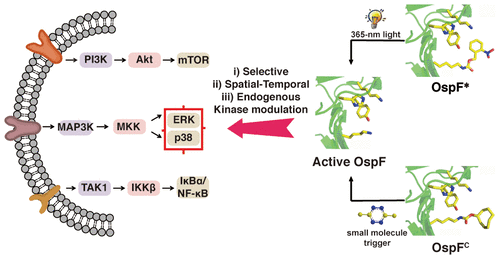当前位置:
X-MOL 学术
›
ACS Cent. Sci.
›
论文详情
Our official English website, www.x-mol.net, welcomes your
feedback! (Note: you will need to create a separate account there.)
Bioorthogonal Engineering of Bacterial Effectors for Spatial-Temporal Modulation of Cell Signaling.
ACS Central Science ( IF 12.7 ) Pub Date : 2018-12-27 , DOI: 10.1021/acscentsci.8b00751 Jingyi Zhao 1, 2 , Yanjun Liu 1 , Feng Lin 1, 3 , Weixia Wang 1 , Shaojun Yang 1 , Yun Ge 1 , Peng R Chen 1, 2, 3
ACS Central Science ( IF 12.7 ) Pub Date : 2018-12-27 , DOI: 10.1021/acscentsci.8b00751 Jingyi Zhao 1, 2 , Yanjun Liu 1 , Feng Lin 1, 3 , Weixia Wang 1 , Shaojun Yang 1 , Yun Ge 1 , Peng R Chen 1, 2, 3
Affiliation

|
The complicated and entangled cell signaling network is dynamically regulated by a wide array of enzymes such as kinases. It remains desirable but challenging to specifically modulate individual, endogenous kinases within a cell, particularly in a spatial-temporally controlled fashion. Current strategies toward regulating the intracellular functions of a kinase of interest either lack specificity or require genetic engineering that may perturb its physiological activity. Herein, we harnessed a bacterial effector OspF for optical and chemical modulation of the endogenous mitogen-activated protein kinase (MAPK) cascade in living cells and mice. The phospho-lyase OspF provided high specificity and spatial resolution toward the desired kinase such as the extracellular signal-regulated kinase (ERK), while the genetically encoded bioorthogonal decaging strategy enabled its temporal activation in living systems. The photocaged OspF (OspF*) was applied to dissect the subcellular signaling roles of ERK in nucleus as opposed to cytoplasm, while the chemically caged OspF (OspFc) was introduced into living mice to modulate ERK-mediated gene expression. Finally, our spatially and chemically controlled OspFc was further used to precisely tune immune responses in T cells. Together, our bioorthogonal engineering strategy on bacterial effectors offers a general tool to modulate cell signaling with high specificity and spatial-temporal resolution.
中文翻译:

细菌效应子的生物正交工程,用于细胞信号的时空调制。
复杂而纠缠的细胞信号网络由各种各样的酶(例如激酶)动态调节。仍然特别需要以空间-时间控制的方式特异性地调节细胞内的各个内源性激酶,但是具有挑战性。调节目的激酶的细胞内功能的当前策略要么缺乏特异性,要么需要可能干扰其生理活性的基因工程。在本文中,我们利用细菌效应子OspF对活细胞和小鼠中内源性有丝分裂原激活的蛋白激酶(MAPK)级联的光学和化学调节。磷酸裂解酶OspF对所需的激酶(例如细胞外信号调节激酶(ERK))具有很高的特异性和空间分辨率,而基因编码的生物正交减量策略使它能够在生命系统中暂时激活。将光笼化的OspF(OspF *)用于解剖ERK在细胞核中的亚细胞信号转导作用,而不是胞质,同时将化学笼化的OspF(OspFc)引入活体小鼠中以调节ERK介导的基因表达。最后,我们的空间和化学控制的OspFc被进一步用于精确调节T细胞中的免疫反应。总之,我们针对细菌效应子的生物正交工程策略提供了一种通用工具,可以以高特异性和时空分辨率调节细胞信号传导。同时将化学笼中的OspF(OspFc)引入活体小鼠中,以调节ERK介导的基因表达。最后,我们的空间和化学控制的OspFc被进一步用于精确调节T细胞中的免疫反应。总之,我们针对细菌效应子的生物正交工程策略提供了一种通用工具,可以以高特异性和时空分辨率调节细胞信号传导。同时将化学笼中的OspF(OspFc)引入活体小鼠中,以调节ERK介导的基因表达。最后,我们的空间和化学控制的OspFc被进一步用于精确调节T细胞中的免疫反应。总之,我们针对细菌效应子的生物正交工程策略提供了一种通用工具,可以以高特异性和时空分辨率调节细胞信号传导。
更新日期:2018-12-27
中文翻译:

细菌效应子的生物正交工程,用于细胞信号的时空调制。
复杂而纠缠的细胞信号网络由各种各样的酶(例如激酶)动态调节。仍然特别需要以空间-时间控制的方式特异性地调节细胞内的各个内源性激酶,但是具有挑战性。调节目的激酶的细胞内功能的当前策略要么缺乏特异性,要么需要可能干扰其生理活性的基因工程。在本文中,我们利用细菌效应子OspF对活细胞和小鼠中内源性有丝分裂原激活的蛋白激酶(MAPK)级联的光学和化学调节。磷酸裂解酶OspF对所需的激酶(例如细胞外信号调节激酶(ERK))具有很高的特异性和空间分辨率,而基因编码的生物正交减量策略使它能够在生命系统中暂时激活。将光笼化的OspF(OspF *)用于解剖ERK在细胞核中的亚细胞信号转导作用,而不是胞质,同时将化学笼化的OspF(OspFc)引入活体小鼠中以调节ERK介导的基因表达。最后,我们的空间和化学控制的OspFc被进一步用于精确调节T细胞中的免疫反应。总之,我们针对细菌效应子的生物正交工程策略提供了一种通用工具,可以以高特异性和时空分辨率调节细胞信号传导。同时将化学笼中的OspF(OspFc)引入活体小鼠中,以调节ERK介导的基因表达。最后,我们的空间和化学控制的OspFc被进一步用于精确调节T细胞中的免疫反应。总之,我们针对细菌效应子的生物正交工程策略提供了一种通用工具,可以以高特异性和时空分辨率调节细胞信号传导。同时将化学笼中的OspF(OspFc)引入活体小鼠中,以调节ERK介导的基因表达。最后,我们的空间和化学控制的OspFc被进一步用于精确调节T细胞中的免疫反应。总之,我们针对细菌效应子的生物正交工程策略提供了一种通用工具,可以以高特异性和时空分辨率调节细胞信号传导。











































 京公网安备 11010802027423号
京公网安备 11010802027423号